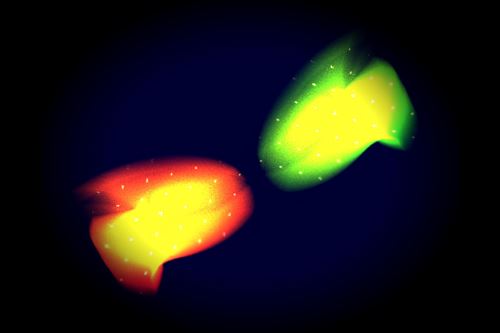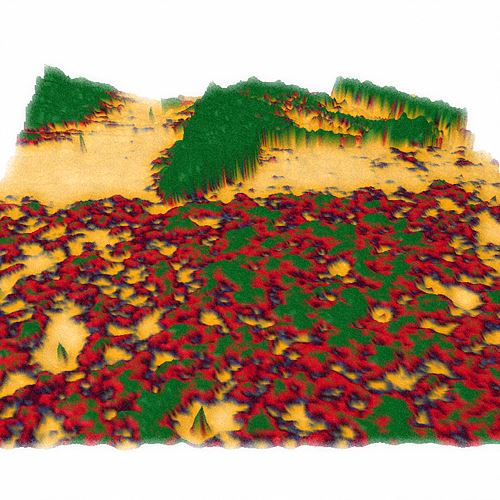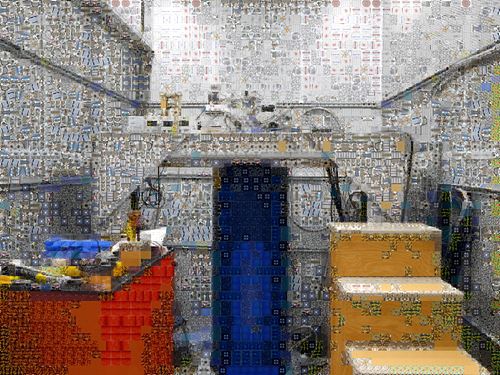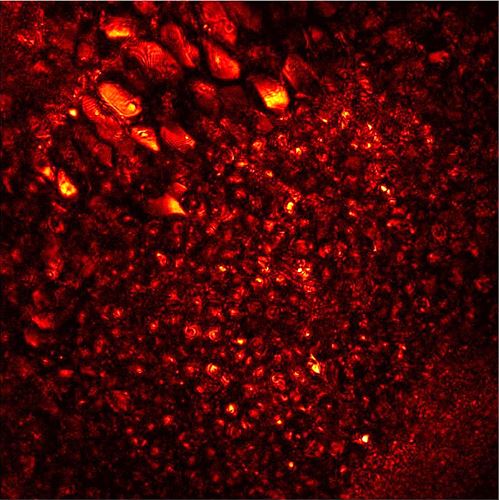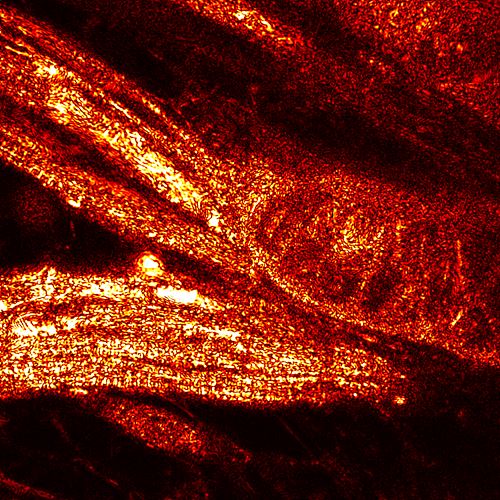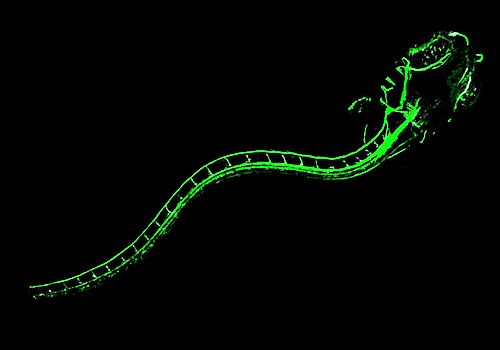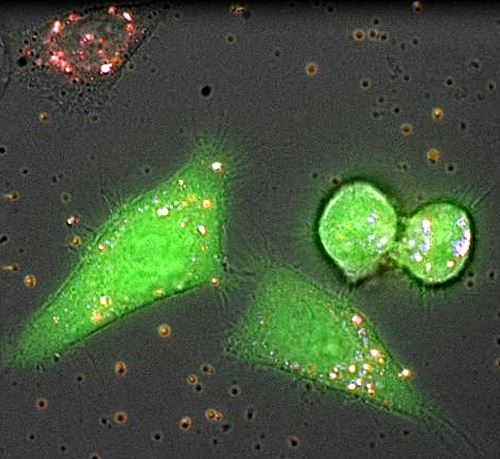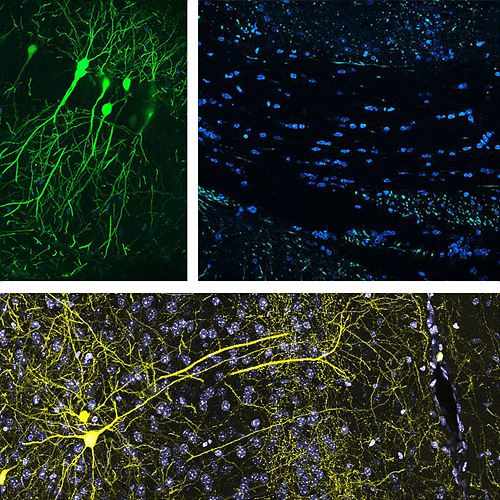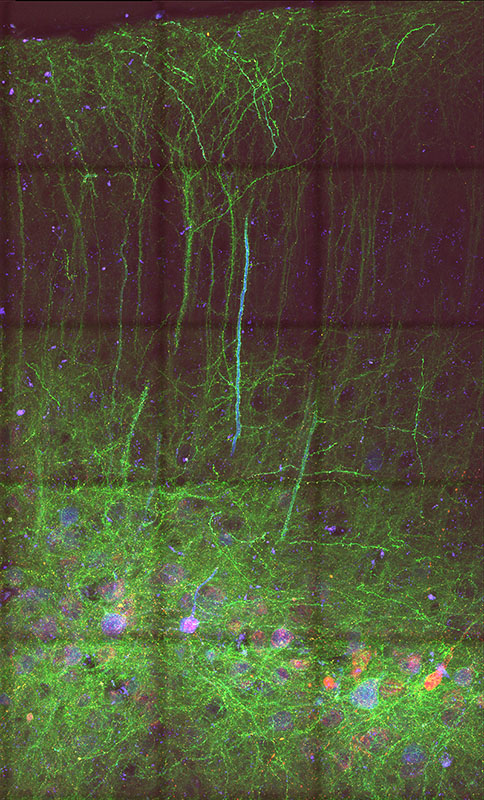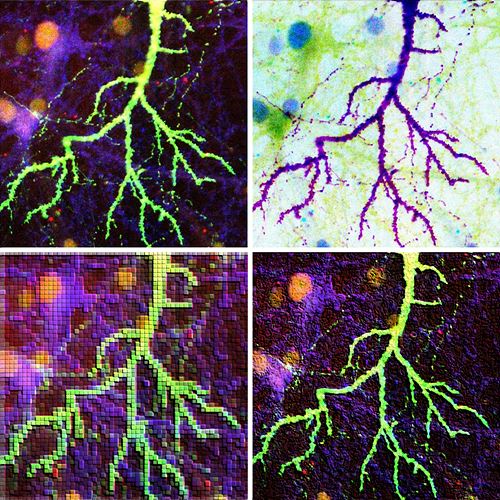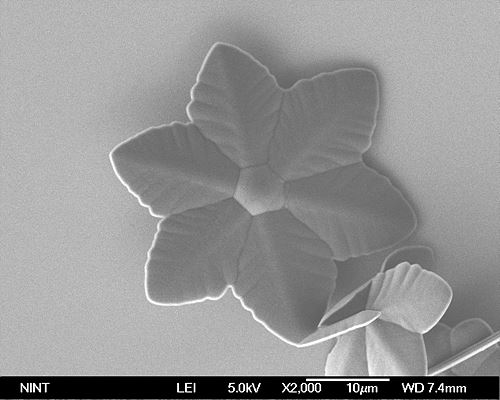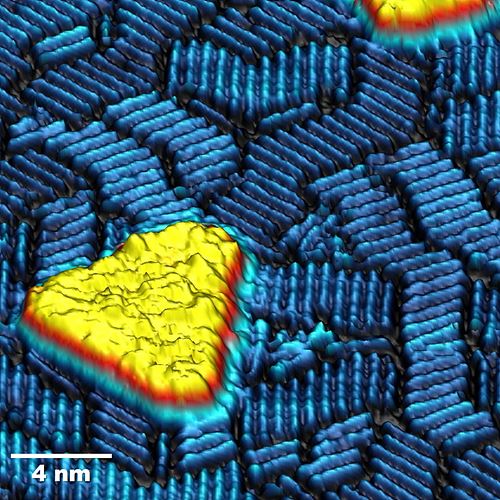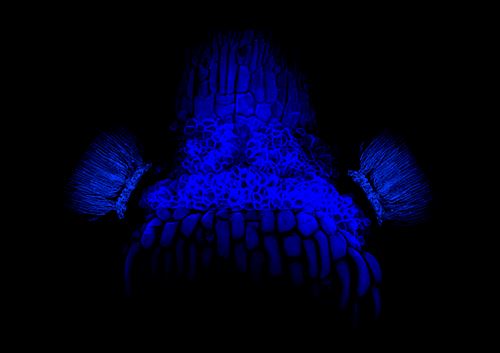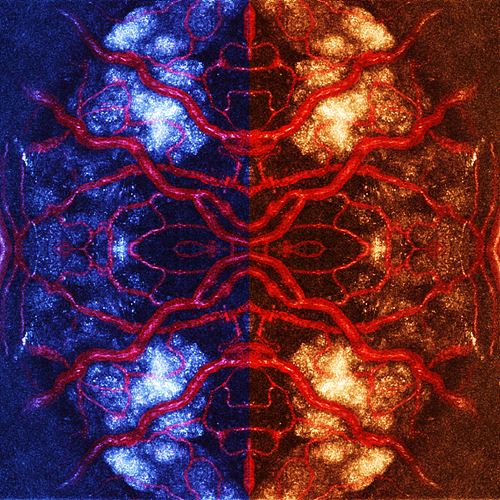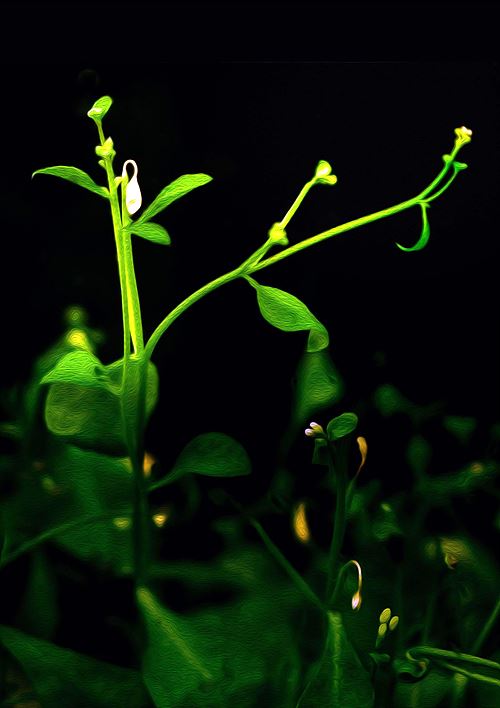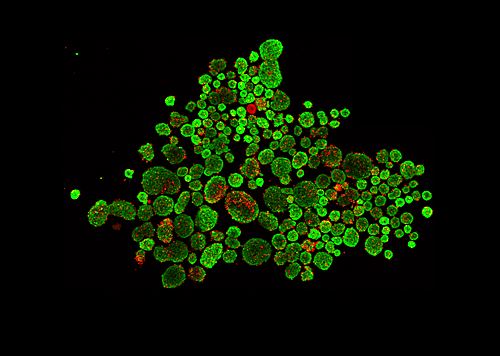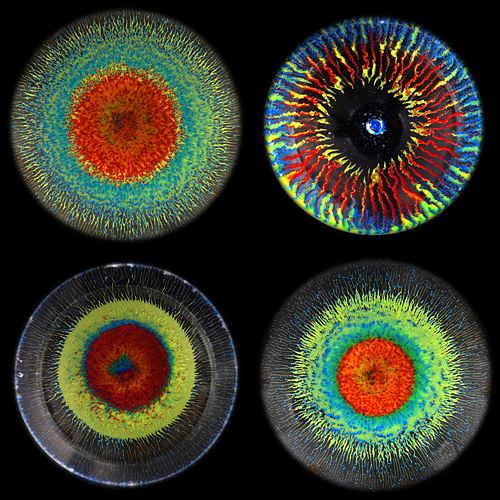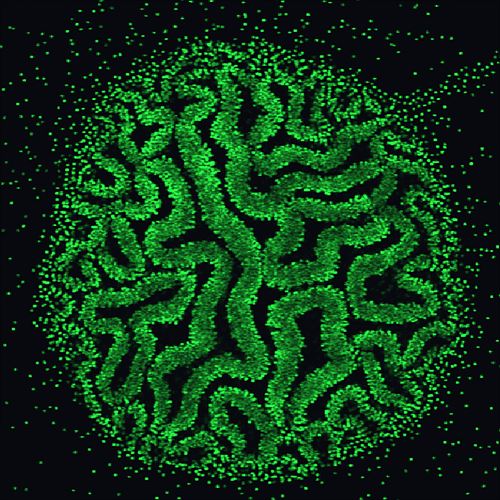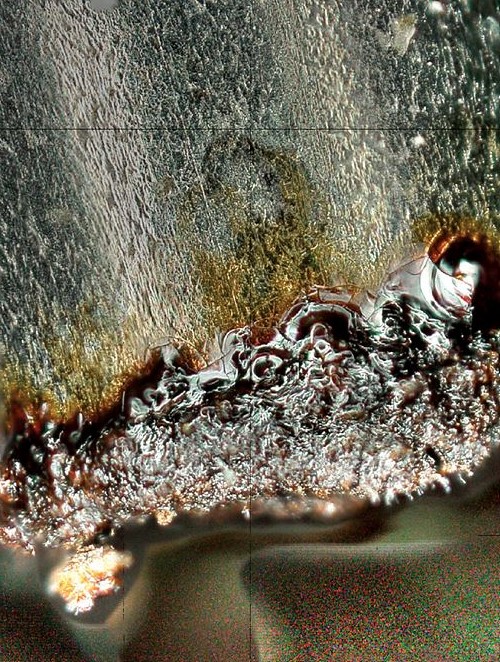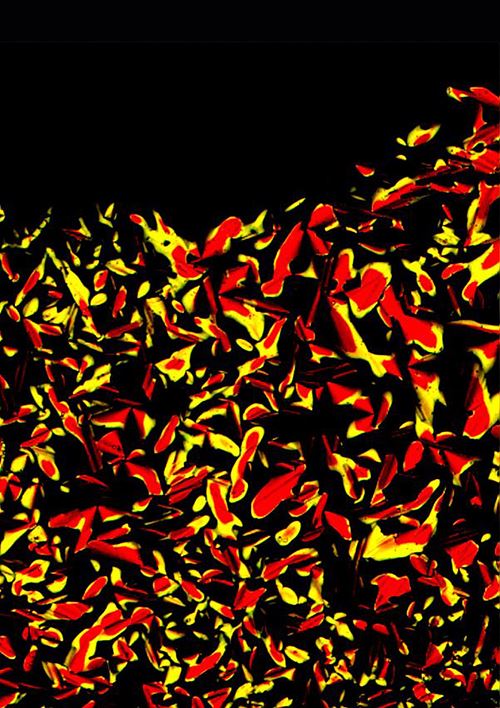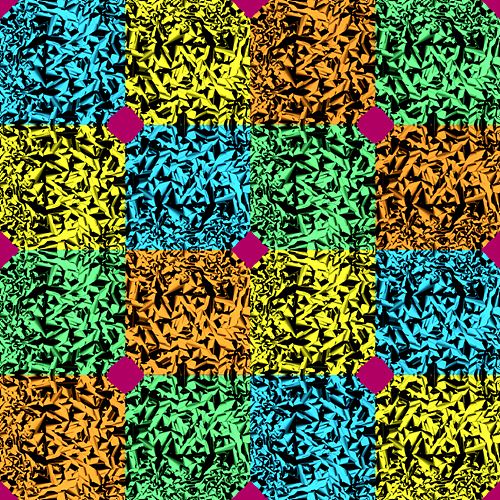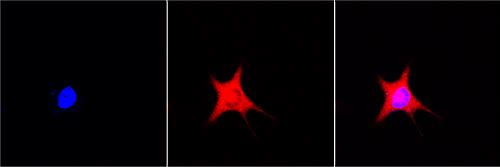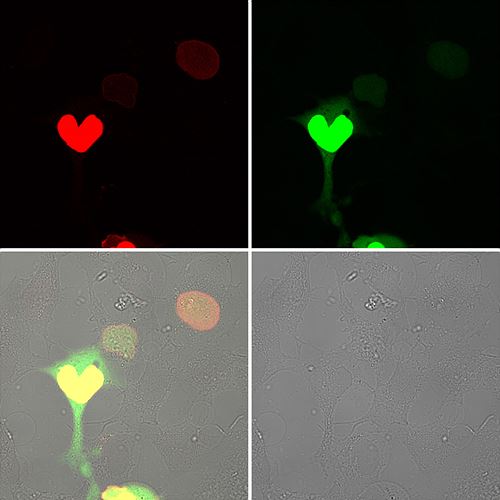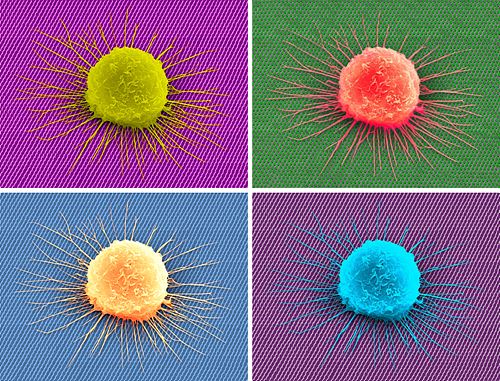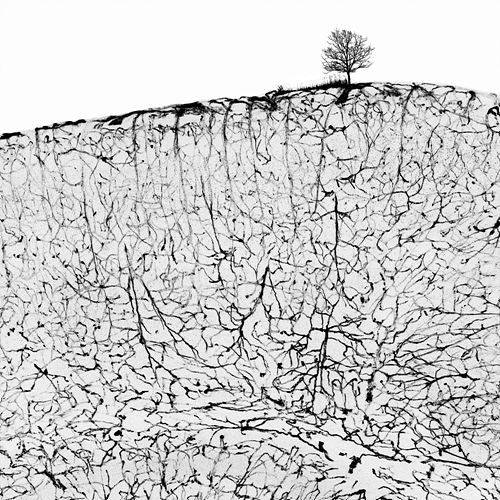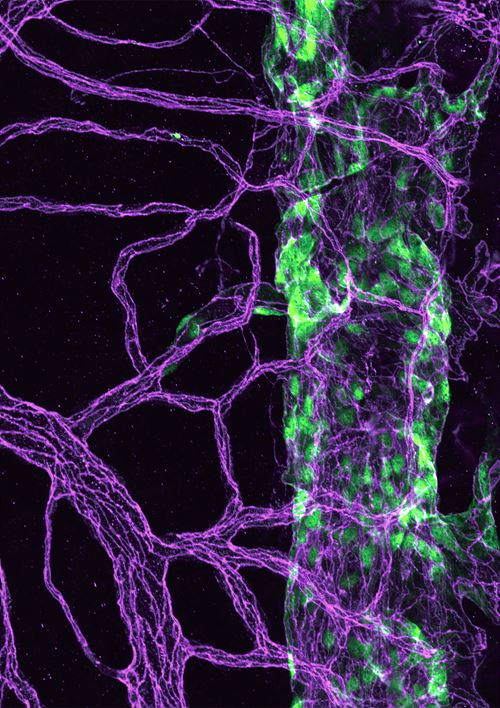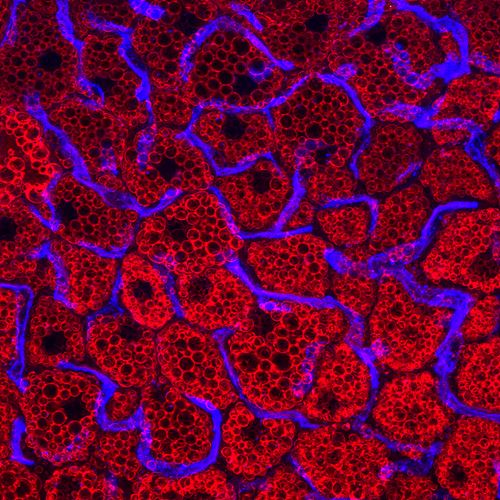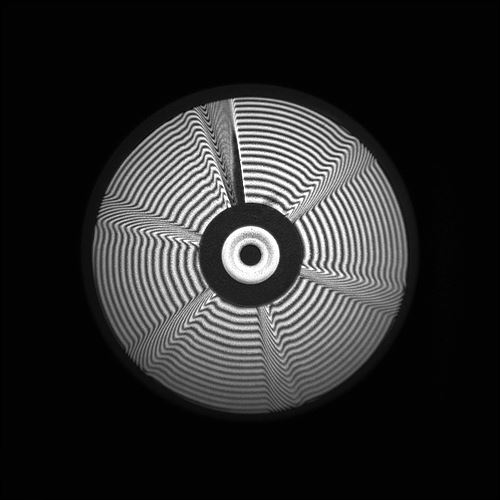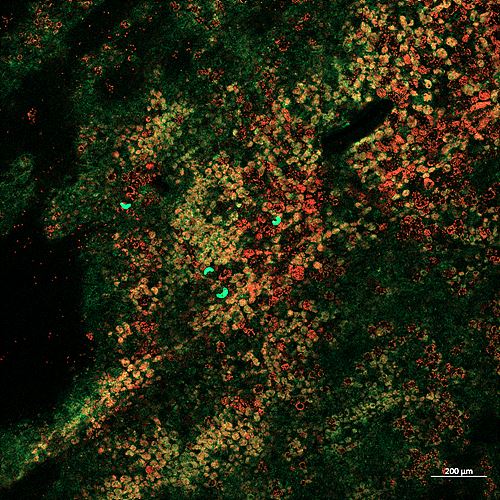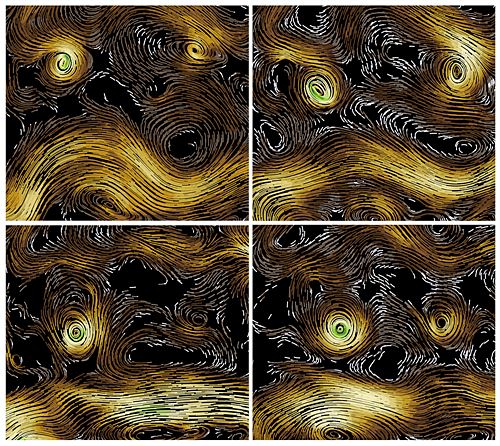Nemo meets Marlin
by Soonmin Kang
Center for Correlated Electron Systems
Single crystal X-ray diffraction (SC-XRD) with 4 axes is an important experimental method to verify the structure of materials. It is possible to observe reciprocal lattice of material by performing SC-XRD and the limited reciprocal lattice occasionally shows interesting patterns in accordance with experimental conditions. The image contains the SC-XRD results of vanadium diselenides (VSe2) at 28 K and 300 K. The results seem to resemble a dramatic meeting of the clownfish character Nemo and his father Marlin who appear together in a Disney film. Blurry lines, dots, and splendid colors of the patterns contrast with the dark background, creating a dreamy atmosphere.
Autumn made of superconductor
by Suhan Son
Center for Correlated Electron Systems
Niobium diselenide (NbSe2), a material synthesized from niobium (Nb) and selenium (Se), is not only a quasi-two dimensional layered material, but also a superconductor which shows zero conductivity in low temperatures. In the figure, the atomic force microscope (AFM)* measurement data obtained after making NbSe2 into several tens of atomic layers by mechanical exfoliation is three-dimensionalized. The colors of the figure result from the thickness differences between layers. It is reminiscent of a mountain where the autumn color comes from a combination of colorful colors.
* Atomic force microscope: It can measure atomic-scale forces between the surface and a probe tip and produce topographic maps of the surface of the particle.
Spectrum of SI-STM 1 (Spectroscopic imaging scanning tunneling microscope)
by Kyoung Seok Lee
Center for Correlated Electron Systems
From design to completion of construction of a spectroscopic imaging - scanning tunneling microscope (SI-STM), we went through a colorful spectrum of memories; joy, excitement, frustration, hope, struggle, etc. The main image is an SI-STM system installed inside an acoustic and vibration isolation facility. The blue cylinder is a 14 T magnet liquid helium dewar, where a STM head and a cryostat are kept at an extremely low temperature. By this photomosaic, we attempt to visualize the fact that a scientific instrument can be built not only upon materialistic components, but also upon other intangible abstract elements as well. This mosaic is more meaningful since each and every pixel of it were crafted from real images of the researchers’ lives.
Leaves blowing in the wind : Inside the brain of a living zebrafish
by Moonseok Kim
Center for Molecular Spectroscopy and Dynamics
This is a movie made of 3-dimensional images of the hindbrain of a living larval zebrafish two weeks after fertilization, which was acquired by label-free high-resolution computational adaptive optical microscopy. The complicated distribution of neurons within 100 μm2 of the field of view is shown from the top to a depth of 100 μm of the brain. Due to the refraction and multiple scattering of light inside the zebrafish, it was previously not possible to acquire high-resolution images with conventional label-free imaging techniques. In order to overcome such a limitation, we have developed a novel computational adaptive optical microscopy which can figure out light distortion and retrieve an original image by fundamental physics. The contrast of the diffraction-limited image is unprecedentedly enhanced, thereby even interference fringes at the membrane can be visualized. The magnificent view of the vanishing neurons reminds us of leaves blowing in the autumn wind.
A muscular zebrafish
by Yonghyeon Jo
Center for Molecular Spectroscopy and Dynamics
This is an image of the muscle tissue of the spinal cord area of the zebrafish 10 days after hatching obtained by a high-resolution aberration-compensated microscope technique with non-labeling. Healthy zebrafish swim fast even in small tanks. Thanks to sturdy muscles, zebrafish can swim vigorously. The separation of the erector spinae muscles and the definition of delicate muscle fibers are prominent. Whether he knew that he would soon be anesthetized and imprisoned in a hard agar, I even feel the will and spirit as he raised his muscles to resist his destiny. Asymmetry composition, flexible shape, and dynamics of the light create a sense of rhythm and space.
Z-dragon (Zebrafish-Dragon)
by Jin Hee Hong
Center for Molecular Spectroscopy and Dynamics
The nervous system of vertebrates is surrounded by the myelin sheath that forms an electrically insulating layer. This is essential for a rapid electrical signal propagation. This image represents the myelination of zebrafish which is widely used as animal models. Green fluorescent protein (GFP) is expressed in cells that construct the myelin sheath of a zebrafish and the image is obtained by a confocal laser microscope*. The central nervous system, consisting of the brain and spinal cord, and the peripheral nervous system of a zebrafish 14 days after hatching are shining with green fluorescence. It looks like the shape of a dragon who is eager to ascend. Strong contrast of colors and oblique composition give the sensation of speed and motion.
* Confocal microscopy: A type of microscopy that uses a laser along with particular optical components to create high-resolution images of materials stained with fluorescent probes.
Now you see me : A trace of nanobiochemisty
by Seongchan Kim
Center for RNA Research
A drug delivery system based on RNA as a drug candidate is a novel strategy to treat various diseases at the molecular level, but still has an undesirable biological barrier of efficient delivery to the target site. We have developed a multifunctional RNA delivery vehicle enabling simultaneous bioimaging based on a highly biocompatible fluorescent nanoparticle (blue) and dye-labelled RNA (red) with simple preparation. Real-time study of fluorescence imaging in live cells (green) shows that the nanoparticle favorably localize in cytoplasm and successfully release RNA. This study suggests the excellent potential for simultaneous bioimaging and gene therapy system.
Der Teil und das Ganze trilogy : Contact, Sandbank, Take off at night
by Kyungdeok Kim
Center for Synaptic Brain Dysfunctions
These figures form a trilogy themed by a saying in Oriental philosophy, “There is small universe in each of our brains.” The first figure, “Take off at night”, provides similarity between the brain structure and a city landscape observed from the sky. The second figure, “Contact,” provides appreciation of synapses and the neurons which compose them. In the last figure, “Sandbank,” information is observed like a stream in which we can gaze. Neurons in the images of the trilogy shine by themselves expressing fluorescent proteins. The name of trilogy originated from an immortal classic, “Der Teil und das Ganze” (“the part and the whole” in English), of Werner Heisenberg (1901-1976), a quantum physicist.
Garden in the brain : Connecting link
by Chaehyun Yook
Center for Synaptic Brain Dysfunctions
Reminiscent of a night forest with wild flowers, this figure shows intermingled structures in a mouse brain, connected to each other by synapses. These connect individual neuron and transmits neuronal activity, forming circuits in a complex neural network. Because of their sheer abundance and tiny size, visualizing synapses together with neuronal process structures necessitates specialized labeling strategies in light microscopy. This figure shows a confocal image of medial prefrontal cortex (mPFC) of Fmr1 knock out mouse, a mouse model for autism and intellectual disability, labeled by mGRASP, a labeling technique to visualize a synapse with its pre- and post-synaptic neurons. Synapses (red puncta) are located at the interface of pre- and post-synaptic neuronal processes (green), whose cell bodies (blue) are located in the deep layer. From this image, we can examine synapse distribution of local circuits of Fmr1-KO mPFC, and infer a connectivity correlation of neurological disorders.
The flash
by Eunkyung Lie
Center for Synaptic Brain Dysfunctions
The four images are the dendrite of cultured pyramidal neuron, obtained from a hippocampus. The brain of human beings consists of about 100 billion nerve cells (neurons). Among them, only one billion pyramidal cells are related with long-term memory. By expressing the fluorescent EGFP proteins in cultured neurons, these images were captured while observing the shape or number of dendritic spines aiding study of the formation of synapses in which synaptic neurotransmission occur. The original (upper left) looks like lightning in the night sky and the other three images express glare, feeling, and afterimage by processing the original image. The four images with different colors and textures combine into one great artwork. The dendrite in the brain also looks like the roots of a plant.
Fullerene flower
by Hee Cheul Choi
Center for Artificial Low Dimensional Electronic Systems
Fullerene is the smallest, stable carbon-based molecule. Recently, many researchers focus on solution-based self-crystallization of fullerene molecules due to their various morphologies and crystal structures with different optical and electrical properties. This figure shows the first reported fullerene flower, which has unique flower-shaped crystals with six symmetric petals followed by co-crystallization* of both C60 and C70 molecules. This unique crystal can be observed due to different solubility of C60 and C70 molecules in mesitylene, which promotes nucleation of C70 with sixfold symmetry in the early stage, and it is followed by co-crystallization of both C60 and C70 molecules.
* The process to grow crystal which contains more than two molecules.
Nanoscale Escher’s stairs
by Jewook Park
Center for Artificial Low Dimensional Electronic Systems
Scanning tunneling microscopy (STM) reveals self-assembled cobalt (Co) nano-islands and tantalum (Ta) nano-rods on a copper (Cu) (111) substrate. We prepared spin-polarized STM and observed ferromagnetic Co nano-islands (yellow). Ta nano-rods form staircase shapes. The atomic level surface image (3D rendering, false-colored) brings to mind the lithography print “Relativity” (1953) by the Dutch artist M. C. Escher. At the same time, the image also resembles a virtual space where a yellow island is floating in a blue ocean with waves rising and falling.
Blue Dokkaebi
by Yuree Lee
Center for Plant Aging Research
The picture shows cell wall of a receptacle after parts of floral organs are shed. An inflorescence of the plant Arabidopsis was stained with calcofluor white, a fluorescent dye that binds strongly to cell walls, and observed with a confocal microscope. Blue fluorescence generated by UV excitation wavelengths looks like the imaginary face of Dokkaebi; traditional Korean goblins. Mysterious blue light gives off a creepy look.
Imagining a brain aging : Color of aging
by Junsoo Park
Center for Plant Aging Research
Brains are developed inside heads, which make them difficult to observe. Due to this characteristic, observation of long-term scale biological events, such as a brain’s aging process, was believed to be nearly impossible. If we can relocate a brain in a location where we can directly observe it, wouldn’t it be possible to observe things that we previously couldn't? We implanted hypothalamic tissue on the iris of an eye. The red color indicates angiogenesis (development of new blood vessels, an indicator of successful implantation) of an implanted tissue . Structure and color were modified to our liking. What would be the shape and color of an aged brain? The image reminds us of an insect or the symmetry image of a mandala.
Sorrow of the weak
by Yuree Lee
Center for Plant Aging Research
Calcium is an essential nutrient for development of plants, and required for structural roles in cell walls and membranes, as well as an intracellular messenger in signal transaction. Insufficient calcium uptake degenerates plant development and growth, which is especially severe for flowers and young leaves. The picture shows the death of a young leaf due to the lack of calcium, which looks like a tear drop.
A Seoul map painted with pancreatic islets
by Jung Hoon Cho
Center for Plant Aging Research
Pancreatic islets situated in the pancreas produce several hormones (i.e. insulin, glucagon) playing a central role in retaining glucose homeostasis in our body. To determine the pancreatic islet cell viability after dimethyl sulfoxide (DMSO) treatment, we used live and dead cell markers, calcein AM (green) and EthD-1 (red). Coincidentally, this image looks like a city map of Seoul drawn with pancreatic islets.
The spinning dust
by Olgierd Cybulski
Center for Soft and Living Matter Bartosz Grzybowski Group
The four photographs show self-assembled patterns of micro-particles suspended in a heavy liquid at the top of a container which rotates about the vertical axis, with cyclically varying speed. The particles of three different sizes, densities and colors are lighter than the surrounding liquid, so they are pressed towards the transparent lid of the rotating container. The centrifugal force, resulted from rotation, pushes them toward the center, whereas the shear forces resulted from torsional shaking, correspond to the radial alignment of particles. Different patterns occur at different speed of rotation.
Colloidal brain
by Ruoyu Dong
Center for Soft and Living Matter
A colloidal cluster formed by acoustic trapping, explodes into this wrinkled structure when both an ultrasound and AC electric field are on simultaneously. This is the consequence of a tug of war between the ultrasound confining potential and the AC induced dipole-dipole interaction. It reminds us of the shape of the human cerebral cortex or a swelling fingerprint. They both share a similar formation mechanism; due to the limited space in a two dimensional plane, the structure tends to evolve in the third dimension, creating a convoluted pattern.
Red bamboo in a capillary : Topological defects in liquid crystals
by Sung-Jo Kim
Center for Soft and Living Matter
Confined liquid crystals struggle to find the most comfortable (lowest energy) structure. They want to minimize their elastic free energy while satisfying boundary conditions. These boundary conditions often present inevitable but beautiful imperfections called topological defects. The photo is a polarized optical microscopy* image of nematic Sunset Yellow (SSY) doped with a minuscule amount of polymer. In this chromonic liquid crystal of very small elastic modulus, chiral domains emerge spontaneously with topological defects between two domains. The shape resembles the structure of bamboo.* Polarized optical microscopy: uses filters to polarize light into waves that vibrate only in one direction
Platinum waterfall
by Yaroslav I. Sobolev
Center for Soft and Living Matter
A dull tip of a platinum wire was used as an electrode for applying high-voltage (3 kV) to a sessile water droplet. The purpose of these experiments was to study how the microscopic surface structure of water changes when it's highly charged. Here you see a magnified photo of the wire tip after one of the experiments. Wire is oriented vertically on the image (you can see the clean part of the wire on the top). Even though we used ultrapure water, some brown organic substance was found on the wire tip (bottom of the image) after 1 day under high voltage - probably due to impurities present in ambient air. This image seems like a piece of contemporary art. The contrast between sleek and rough surface and swelling silver waves maximize an abstract atmosphere.
Sunset over Hades
by Karel Goossens
Center for Multidimensional Carbon Materials
‘Deep down in the Underworld, where restless souls are wandering in eternity, yet another day comes to an end. The sky turns dark, but the flames never cease to give off their relentless heat, melting everything that comes too close.’ This is what came to my mind when this beautiful texture of a molten liquid crystal appeared in my polarized light optical microscope*. The image provided some clues about the nanoscale organization of molecules in the birefringent** sample, due to characteristic interference effects. It marked the starting point for a detailed study by X-ray diffraction, which revealed that these molecules form an intricate hexagonal columnar mesophase with a triangular cylinder like morphology.
* Polarized light microscopy: A useful method to generate contrast in birefringent specimens and to determine qualitative and quantitative aspects of crystallographic axes present in various materials.
** Birefringent: Optical property of a material having a refractive index that depends on the polarization and propagation direction of light.
Psychedelic liquid crystals
by Karel Goossens
Center for Multidimensional Carbon Materials
Watch out! Looking for too long through a microscope may cause a massive headache! Yet it is impossible to get bored while looking at the intriguing "fan-like defect" textures of liquid crystals when they are seen through crossed polarizers. The image is an artistic interpretation of the effects of introducing a so-called "full-wave retardation plate" in between the sample and the second polarizer (analyzer). By determining which color appears in which direction, it is possible to obtain information on the orientation of the rod-like aromatic cores of the molecules in a columnar liquid-crystalline mesophase. If the fan-like defects in the southwest-to-northeast direction appear yellow-orange while those in the southeast-to-northwest direction are colored blue-green, then the aromatic segments are most probably oriented parallel to the supramolecular columns. The reverse situation indicates that the aromatic parts are oriented perpendicularly with respect to the long axes of the columns.
Red star
by Seon Gyeong Lee
Center for Genomic Integrity
Mammalians including human have 3 types of adipose tissue. The brown fat tissue generates heat and increases tissue size in response to a cold condition. Brown adipocyte has many mitochondria. The mitochondria cannot generate energy and die in mass when exposed to stress or cytotoxic conditions. We took a picture of a cell after knocking-down a gene which regulates genomic integrity. We stained mitochondria red and nucleus blue, using Mitotracker and DAPI, respectively. Merging image looks like a destroyed red star.
L'Elisir d'amore
by Jung Me Hwang
Center for Genomic Integrity
The title of this work is a love potion (L'elisir d'amore). The heart represents the dramatic encounter and survival of love on the battlefield. It is an image captured using CUPID technology (protein binding analysis technique) which analyzes the binding of proteins. Protein MSH2 (red) and protein MSH3 (green) in association with protein PKC migrate to the same place on the cell membrane after being exposed to the drug PMA. While observing their migration, this work captured the moment when both proteins reach the membrane, highlighting its heart shape. It is a love potion that comes from drugs. Both proteins play an important role by participating in various mechanisms by intracellular genetic factors, and with this technique, its process can be studied in detail.
Cell flower blooming on the nano-grass
by Chaejeong Heo, Chanho Jeong, Tae-il Kim
Center for Neuroscience Imaging Research
While we were developing geometry-controllable nanohairs that mimic cacti spine-like stooped hairs and studying cell migration behavior on these hairy structures, we decided to color a scanning electron microscope (SEM)* image that resembled a flower bud and grass. The decision to make the images into a 2x2 array with vivid colors was a nod to Andy Warhol's pop art format. The work related to this image of neuroblastoma was published in Nanoscale (Nanoscale, 2017, 13 Sep. DOI: 10.1039/C7NR04522K).
* Scanning electron microscope: An advanced microscope that uses a focused beam of electrons to produce an image of a sample's surface.
The root of being, vessels
by Yoo Hyung Kim
Center for Vascular Research
Angiogenesis is an essential element for organ development and maturation. The blood vessels of the brain extend from the outermost surface into the parenchyma like a root of trees spreading out into the soil. At the same time, the blood vessels of the brain form a tighter barrier than the blood vessels of other organs. Overall, these are crucial processes that protect the brain while promoting brain maturation. The figure shows beautifully organized brain vessels of a postnatal 12-day-old mouse. Interestingly, by drawing a tree on the surface of the brain, the figure expresses the feeling that vessel development is essential for life, as root growth is essential for trees. The tree and complex of blood vessels in black and white are reminiscent of a water and ink painting.
The stream of river flowing in our eyes
by Jaeryung Kim
Center for Vascular Research
This image, which looks like a green pillar surrounded by purple ivy, shows Schlemm's canal and blood vessels in an eye. Eyes maintains their shape and intraocular pressure by continuous production of aqueous humor. Schlemm's canal (green color) encircling peripheral cornea has a critical role for the drainage of aqueous humor into blood vessels (purple color). When normal drainage of aqueous humor is impaired, intraocular pressure is increased and the optic nerve is subsequently damaged, inducing glaucoma and vision loss. Researchers in IBS suggested a potential therapeutic target by demonstrating the new mechanism for development and progress of glaucoma. Although this seemingly river in the eye reminds us of a tear, we can feel hope in conjunction with these research results.
Raspberry fields of blood
by Hosung Bae
Center for Vascular Research
Adipose tissue is highly vascularized and most adipocytes (red) are supported by an extensive vascular network (blue). Brown adipose tissue has an especially large network of blood vessels. Mitochondria-packed brown adipocytes burn energy and produce heat. The image of adipocytes is reminiscent to raspberries, which have been known for burning fat. Blood vessels, sustaining brown fat, can be compared with stems that provide raspberries with necessary nutrients. The strong color contrast of red and blue makes the image look dynamic.
Light donut factory
by Cheonha Jeon
Center for Relativistic Laser Science
We have designed a spherical phase mirror that operates at an angle of 45 degrees to generate a donut shaped beam for light matter interaction. This is an interferometric image of the phase mirror surface. The surface is constructed of six different steps, and as the laser light reflects from the surface, the path difference is λ/3 for each step and 2λ for the combined steps. Due to this path difference, when focused, the beam will have a donut shaped profile. This high intensity donut profile beam will generate a pillar of electrons at the center as it interacts with matter. This will result in proton acceleration that focuses at the center and these accelerated protons can be used for proton therapy for cancer. The bending image with radiating circular waves and the interference pattern is associated with op art.
Is it real?
by Beum-Chang Kang
Center for Genome Engineering
When a gene of interest is introduced into a plant cell together with a fluorescent protein gene, the presence or absence of the gene can be determined through the observation of fluorescence. The most difficult factor to overcome while observing the fluorescence of transformed plant tissue with confocal microscopy is autofluorescence from plant cells. Autofluorescence may look green like a fluorescent protein, but the real color is different. The photograph shows the expression of a fluorescent protein introduced in stomata in plant tissues using confocal microscopy*. The image looks like vivid yellow-green stains on an aerial photo of mountains covered with autumn leaves, creating a disparate and peculiar atmosphere.
* Confocal laser microscopy: A type of microscopy that uses a laser along with particular optical components to create high-resolution images of materials stained with fluorescent probes.
Stormy night
by Seung-Bu Park, Sun-Seon Lee, Jung-Eun Chu
Center for Climate Physics
Hurricanes (typhoons) are feared for their destructive power, but when simulated on computers they exhibit unprecedented natural beauty. This image shows the time-evolution of a pair of computer-generated typhoons over the Indian Ocean and their interaction with a meandering westerly wind jet. The numerical model used for this animation captures the dynamics of the global coupled atmosphere/ocean/land and ice system with a resolution of about 25 km. ICCP scientists conducted the numerical experiment on a supercomputer in the United States. The title "Stormy Night" was inspired by Vincent van Gogh's masterpiece, The Starry Night.
A message from the past
by Axel Timmermann, Karl Stein, Elke Zeller
Center for Climate Physics
"Li circuli delli rami degli alberi segati mostrano il numero delli suoi anni, e quali furono più umidi o più secchi la maggiore o minore loro grossezza."
(The circles of the branches of the sawn trees show the number of their years, and which ones were damp or dry the greater or lesser their thickness.)
Leonardo da Vinci, Trattato della Pittura
Tree growth only occurs in the outermost section of the tree, in a layer under the bark that is only a few cells thick. Outside tropical regions, the rate of tree growth changes throughout the year, creating distinct annual rings. Leonardo da Vinci first related the thickness of the annual rings to the amount of rainfall received during the year. ICCP scientists use tree ring data to gain information about past climates and past changes in ecosystems. The image shows 4 sections of a tree core sampled by Axel Timmermann from a high elevation site in Hawaii. In addition to using the visual images, scientists also analyze stable carbon isotopes within the tree rings, which give them an insight into subseasonal climate variations and changes in photosynthesis.
